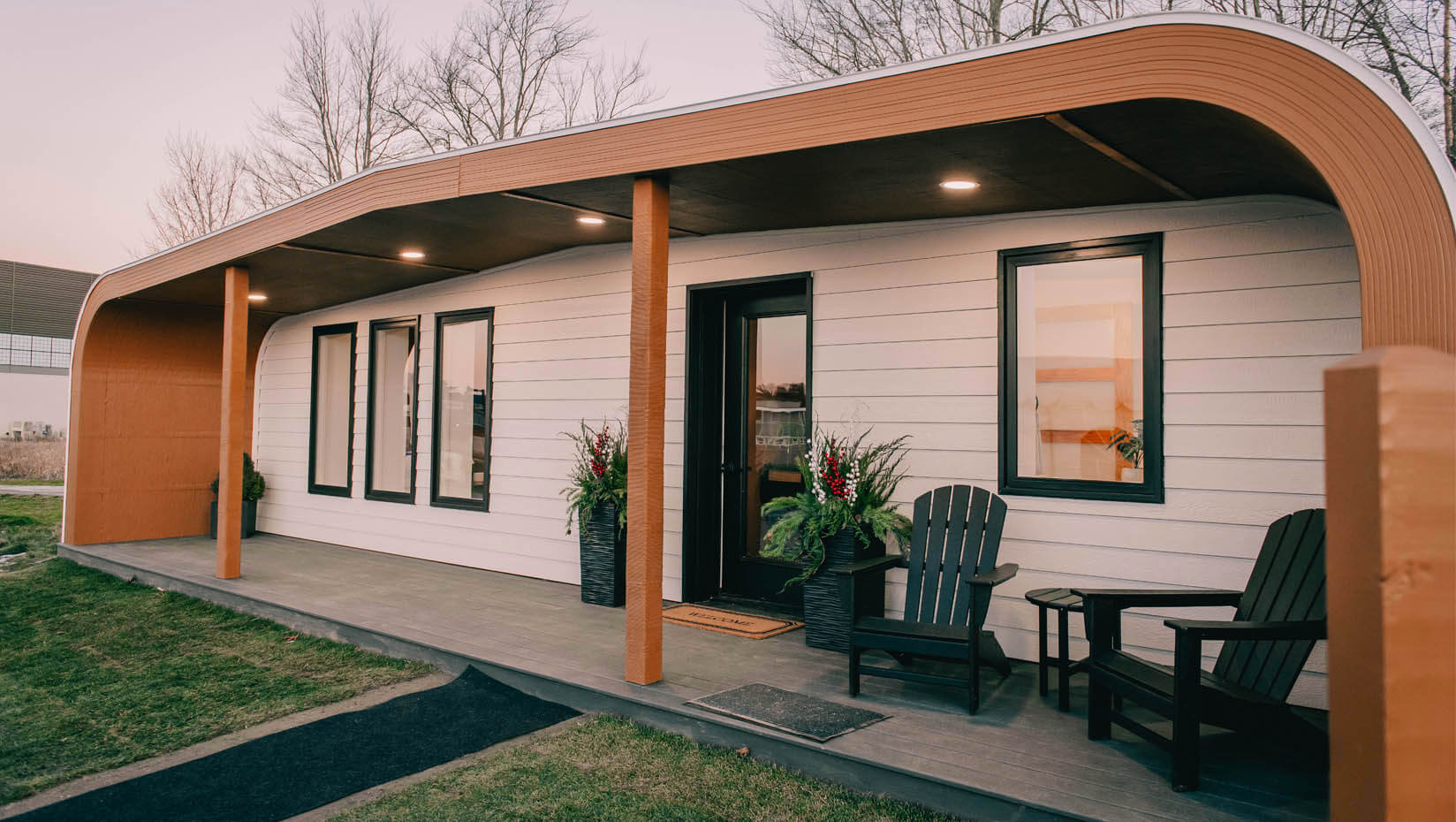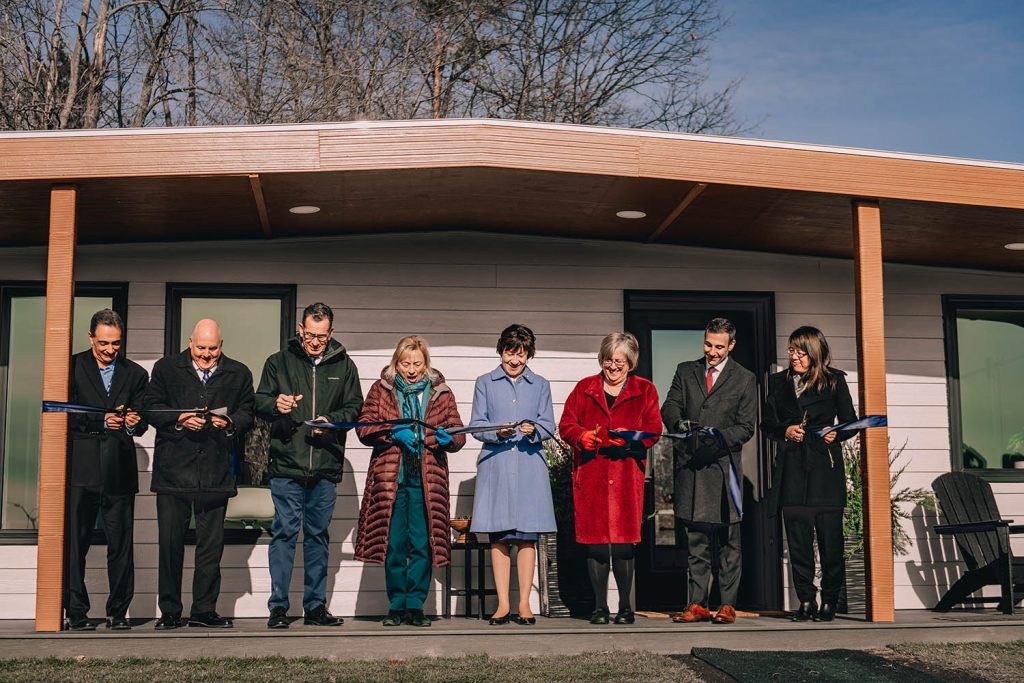
First 100% bio-based 3D-printed home unveiled at the University of Maine
On Nov. 21, the University of Maine Advanced Structures and Composites Center (ASCC) unveiled BioHome3D, the first 3D-printed house made entirely with bio-based materials. BioHome3D was developed with funding from the U.S. Department of Energy’s Hub and Spoke program between the UMaine and Oak Ridge National Laboratory. Partners included MaineHousing and the Maine Technology Institute.
The 600-square-foot prototype features 3D-printed floors, walls and roof of wood fibers and bio-resins. The house is fully recyclable and highly insulated with 100% wood insulation and customizable R-values. Construction waste was nearly eliminated due to the precision of the printing process.
“Our state is facing the perfect storm of a housing crisis and labor shortage, but the University of Maine is stepping up once again to show that we can address these serious challenges with trademark Maine ingenuity,” said Gov. Janet Mills. “With its innovative BioHome3D, UMaine’s Advanced Structures and Composites Center is thinking creatively about how we can tackle our housing shortage, strengthen our forest products industry, and deliver people a safe place to live so they can contribute to our economy. While there is still more to be done, today’s development is a positive step forward — one that I was proud to support through my Maine Jobs & Recovery Plan and my budget. I extend my congratulations and thanks to the University of Maine and its partners, and I look forward to continuing to tackle these problems with innovative solutions.”

The U.S. and Maine, in particular, are experiencing a crisis-level shortage of affordable housing. The National Low Income Housing Coalition reports that nationally, there is a need for more than 7 million affordable housing units. In Maine alone, the deficit is 20,000 housing units and growing each year, according to the Maine Affordable Housing Coalition. Nearly 60% of low-income renters in Maine spend more than half of their income on housing. This untenable situation is exacerbated by the twin challenges of a labor shortage and supply chain-driven material price increases.
In addition to Mills, those participating in the unveiling event included U.S. Sen. Susan Collins; Jeff Marootian, senior advisor for energy efficiency and renewable energy for the U.S. Department of Energy; Rebecca Isacowitz, acting chief of staff for the office of energy efficiency and renewable energy at the DOE; Steve McKnight, acting advanced manufacturing office director for the DOE; and Xin Sun, associate laboratory director for energy science and technology with the Oak Ridge National Laboratory. The leaders toured ASCC, provided remarks and participated in the ribbon cutting ceremony. Also in attendance were legislators, housing advocates and developers, and Maine high school and university students.
“With today’s production of the world’s first ever 3D-printed house made from recycled forest products, the University of Maine continues to demonstrate its global leadership in innovation and scientific research,” said Sen. Collins. “This remarkable accomplishment was made possible by the tenacity and expertise of Dr. Habib Dagher, his team and students at the UMaine Advanced Structures and Composites Center. I commend them on pioneering this new market opportunity for Maine’s forest products industry, which could help alleviate our nation’s housing shortage. Their groundbreaking work will lay the foundation for the future of affordable housing and help create new jobs across our state.”
The technology is designed to address labor shortages and supply chain issues that are driving high costs and constricting the supply of affordable housing. Less time is required on-site building and fitting up the home due to the use of automated manufacturing and off-site production. Printing using abundant, renewable, locally sourced wood fiber feedstock reduces dependence on a constrained supply chain. These materials support the revitalization of local forest product industries and are more resilient to global supply chain disruptions and labor shortages.
Using the advanced manufacturing processes and materials developed at UMaine, future low-income homes can be customized to meet a homeowner’s space, energy efficiency and aesthetic preferences. Importantly, as the manufacturing technology and materials production are scaled up, homebuyers can expect faster delivery schedules.
“We are finding solutions here at ASCC to the pressing problems that our world faces and that Maine faces, through research on transformative offshore wind technology, next-generation solutions for transportation infrastructure, advanced forest products and large-scale 3D printing, and of course, affordable housing,” said UMaine President Joan Ferrini-Mundy. “The work that goes on in this lab absolutely exemplifies the work of a land grant institution — an institution that was started in order to help to solve the problems of, and further the economic advancement of, the state of Maine in partnership with the people of Maine. I couldn’t be more proud to point to this lab and exactly how that’s happening right here.”
The prototype is currently sited on a foundation outside ASCC, equipped with sensors for thermal, environmental and structural monitoring to test how BioHome3D performs through a Maine winter. Researchers expect to use the data collected to improve future designs.
BioHome3D was printed in four modules, then moved to the site and assembled in half a day. Electricity was running within two hours with only one electrician needed on site.
“Many technologies are being developed to 3D print homes, but unlike BioHome3D, most are printed using concrete. However, only the concrete walls are printed on top of a conventionally cast concrete foundation. Traditional wood framing or wood trusses are used to complete the roof,” said Dagher, ASCC executive director. “Unlike the existing technologies, the entire BioHome3D was printed, including the floors, walls and roof. The biomaterials used are 100% recyclable, so our great-grandchildren can fully recycle BioHome3D.”
“It’s these type of public-private collaborations, supported by DOE’s Advanced Materials and Manufacturing Technologies Office, that will help spur innovation in our manufacturing sector. These partnerships across industry, academia, government and our national labs have ushered in critical new technologies that are reducing emissions, improving efficiency, and making our manufacturing stronger, more resilient and more sustainable,” said Marootian, also the nominee for assistant secretary of the DOE.
According to the United Nations Environment Programme, buildings account for nearly 40% of global carbon emissions. Sustainably grown wood fiber is a renewable resource that captures carbon during the tree growth cycle. BioHome3D may be thought of as a carbon storage and sequestration unit during its lifetime and after it is recycled.
This project is the product of strong partnerships in and beyond the UMaine community. The DOE-funded Hub and Spoke Program between UMaine and Oak Ridge National Laboratory is leading the research and development of sustainable, cost-effective bio-based 3D printing feedstock alternatives, such as the material used for BioHome3D. The Hub and Spoke program is a direct result of a request initiated in 2016 by Sens. Collins and Angus King for a U.S. Department of Commerce Economic Development Assessment team to help Maine bolster the forest economy and create jobs and opportunity in rural regions of the state following the closure of several large paper mills.
Oak Ridge National Laboratory’s Manufacturing Demonstration Facility, a leader in advanced manufacturing, and UMaine, home to ASCC, Forest Bioproducts Research Institute and School of Forest Resources, are natural partners in the field of large-scale, bio-based 3D printing. The Maine Technology Institute supported the design of the prototype, and MaineHousing was a key partner in developing and reviewing the specifications for the home in alignment with low-income housing standards.
“This program shows the power of scientific collaboration to address critical national needs,” said Sun. “Uniting the capabilities and facilities of ORNL with UMaine’s expertise and drive for innovation, we have together achieved a significant milestone in the development of sustainable materials and manufacturing technologies, and decarbonizing the buildings sector.”
This effort has been made possible by advances in large-scale additive manufacturing coupled with innovations in bio-based material chemistries that have emerged from these partnerships.
“This project gives us a real possibility to achieve something that has eluded us to-date, and that is the speed of production, to be able to mass produce in a very fast way housing. …The idea that we can create housing units in a fraction of the time with a fraction of the workforce — that is an efficiency that we’ve never experienced before. It’s going to stretch our precious state and federal resources exponentially, and most importantly, provide — quickly — for those most in need in our state,” said Daniel Brennan, director of MaineHousing.
The successful print of BioHome3D builds on the ASCC’s demonstrated excellence in advanced manufacturing, design and modeling. The prototype was printed on the world’s largest polymer 3D printer, which, in 2019, produced the world’s largest 3D-printed boat.
ASCC will be able to scale its advanced manufacturing research in housing construction with the opening of the Green Engineering and Materials (GEM) research Factory of the Future. When complete, GEM will serve as a hub for AI-enabled large-scale digital hybrid manufacturing. The Factory of the Future will drive innovation-led economic recovery in Maine, with bays dedicated to scaling up the production of housing, such as BioHome3D, as well as boatbuilding, an important Maine industry.
A key aspect of the GEM facility is preparing the workforce of the future through immersive world-class educational opportunities at the nexus of engineering and computing. GEM is at the core of the university’s plan to create the new Maine College of Engineering, Computing and Information Science’s (MCECIS), which integrates engineering and computing education and research. The new GEM facility will be for engineering and computing comparable to a teaching hospital in the medical field, where engineering, computing and information science students learn by working in the lab next to world-class faculty and staff. This effort is supported by the Harold Alfond Foundation and UMS TRANSFORMS, with a goal to double the output of engineers and computing and information scientists to meet workforce needs of the state.”
“Workforce and economic development are essential components of ASCC’s world-class research,” says University of Maine System Chancellor Dannel Malloy. “Our federal and state policymakers know that an investment in Maine’s research university is an investment in the state’s future. We appreciate the shared vision and the opportunity to continue to show demonstrated return on investment through initiatives like BioHome3D and the students getting hands-on learning today to carry on the work tomorrow.”
Already, $25 million in direct investment has been secured for GEM, including $15 million through the Maine Jobs & Recovery Plan — the proposal put forth by Gov. Mills and supported by the Maine Legislature to invest the state’s share of federal American Rescue Plan relief funds — and $10 million in the FY22 federal budget thanks to funding requested by Sens. Collins and King. Nearly $40 million in other federal funds championed by Sens. Collins and King are pending for the project.
The Advanced Structures and Composites Center is a world-leading interdisciplinary center for research, education and economic development, encompassing material sciences, advanced manufacturing and engineering of composites and structures. Housed in a 100,000-square-foot ISO-17025-accredited facility, the center has been recognized nationally and internationally for cutting-edge research programs leading and impacting new industries, including offshore wind and marine energy, civil infrastructure, biobased composites, large-scale 3D printing, soldier protection systems and innovative defense-related applications.
Contact: Taylor Ward, 207.852.4530; taylor.ward@maine.edu
